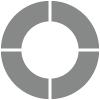Touch Rules: How and When
Want to avoid over-surveying participants? Good choice! Smart planning can make a big difference in helping to balance your survey calendar. To make things even easier, meet Touch Rules!
Touch Rules offer a smart tech solution to avoid the common mistake of over-surveying by preventing email invitations from being sent to the same contacts repeatedly.
Navigate to
- Types of Touch Rules
- Touch Rule Implementation and Limits
- Survey Invitation Sources and Rules
- Applying Touch Rules
- Important Technical Considerations
Types of Touch Rules
Touch Rules offer advanced options for managing survey distribution and reducing survey fatigue. They help you control how and when participants receive survey invitations while ensuring you gather meaningful data. This guide will walk you through each type of Touch Rules and explain how they work in different scenarios.
1: Email-Based Touch Rules
Email-based Touch Rules represent the foundation of survey management. These rules work directly with email addresses, functioning like a mailing list manager that monitors contact frequency. They are ideal for straightforward survey scenarios where you don’t need to track individual identities or complex behaviors.
Consider a customer satisfaction program where you want to limit each email address to three survey invitations per month. The system will track each email address independently, even if multiple email addresses belong to the same person.
2: Contact-Based Touch Rules
Contact-based Touch Rules offer a more sophisticated approach by tracking individual participants through unique Contact IDs. This becomes particularly important when multiple people share an email address.
For example, imagine three employees sharing info@company.com. With email-based Touch Rules, sending a survey to this email address might allow one employee to participate but prevent the others from receiving invitations. Contact-based rules solve this by tracking each person’s unique Contact ID, allowing all three to receive invitations independently.
This option works well for:
- Organizations where multiple employees share departmental emails
- Companies with branches using the same general contact email
- Teams using role-based emails (like support@company.com)
- Parents with their email address for their kids at a school
3: Contact Field Touch Rules
Contact Field Touch Rules add another level of sophistication by grouping participants based on shared characteristics such as city, department, or role. Think of these as quota management tools for different categories of contacts.
For instance, in a global customer satisfaction program, you might want 100 responses from each city. If you set Touch Rules based on city, the system will track and manage invitation and participation limits for each city separately, ensuring balanced geographical representation.
4: Activity Field Touch Rules
Activity Field Touch Rules focus on participant interactions with your business, maintaining quotas based on specific Activity fields like “Agent Location” in support interactions or “Purchase Category” in sales transactions.
For example, in a support satisfaction survey, you might want equal feedback from each agent location. The system manages invitation and participation quotas per location to maintain balanced feedback across your support operations.
Touch Rule Implementation and Limits
All Touch Rules allow you to set both invitation and participation limits within a specified timeframe. The timeframe is a crucial component that you define when setting up the rules. For example, you might set limits for a day, week, month, or any other time period that suits your survey program needs.
These limits work together within the same Touch Rule type using “OR” logic. This means that when both limits are applied, a participant becomes ineligible for future invitations if they reach either limit within the specified timeframe. The rules only combine limits of the same type – you cannot mix limits across different rule types.
For example: If you have a client who regularly contacts your support team and attends webinars and you’ve set up Activity Field Touch Rules for both post-support and post-webinar surveys to each allow three invitations per client per month, your client will only receive three total invitations to either of those surveys in a single month.
Survey Invitation Sources and Rules
When the platform reviews invitations in order to apply Touch Rules, it takes many factors into consideration. In addition to timeframe, the type of Touch Rules, as listed above, and the source of the contacts are both important. Sources include:
- Basic Sources: Type Manually, Contact List, or File
- Directory
- Directory with Activity
The following examples illustrate how Touch Rules work in each scenario. The review process refers to the platform’s protocol for reviewing previously sent invitations.
1: Email-Based Touch Rules
- Invitation Limit Rule: Stops sending invitations if an email address has received x invites within y timeframe (e.g., 3 invitations within 30 days)
- Participation Limit Rule: Stops sending invitations if an email address has participated x times within y timeframe (e.g., 2 participations within 30 days)
- Review Process: The system examines invitations within the specified timeframe (y) and:
- For Basic Sources (Type Manually, List, or File) OR Directory OR Directory with specific Activity:
- Reviews email addresses that received invitations within the timeframe
- Filters based on defined criteria for that timeframe
- No email address is sent invitations more than the specified criteria
- For Basic Sources (Type Manually, List, or File) OR Directory OR Directory with specific Activity:
2: Contact-Based Touch Rules
- Invitation Limit Rule: Stops sending when a Contact ID receives x invites within y timeframe (e.g., 5 invitations within a quarter)
- Participation Limit Rule: Stops sending when a Contact ID participates x times within y timeframe (e.g., 3 participations within a quarter)
- Review Process:
- For Basic Source previous invitations: Treats Contact IDs of previously used email addresses as first contact within the timeframe
- For Directory previous invitations (Contact-Based, Field, or Activity):
- Reviews Contact IDs that received invitations within the timeframe
- Filters based on defined criteria for that timeframe
- No contact ID is sent invitations more than the specified criteria
3: Contact Field Touch Rules
- Invitation Limit Rule: Sends up to x invites per field value within y timeframe (e.g., 100 invitations per city within a month)
- Participation Limit Rule: Continues sending invites to a field value until x responses are received within y timeframe (e.g., until 50 responses per department are received within a quarter). In this rule it’s possible to receive more than x responses per contact field in y timeframe, as the system keeps sending invitations to all eligible contact IDs until the participation quota is reached.
- Additional Considerations:
- The system focuses on achieving quotas per contact field value within the specified timeframe.
- Contact IDs sent invitation once are not automatically excluded from subsequent runs. To avoid duplicate invitations, when setting up automation rules use: added/updated since last run options.
- Contact IDs might receive multiple invites if the rule runs multiple times within the timeframe for same Contact IDs.
- Review Process: The system reviews the specified timeframe (y) and:
- For Basic Source previous invitations: Treats Contact IDs of previously used email addresses as first contact within the timeframe
- For Directory previous invitations (Contact-Based, Field, or Activity):
- Reviews Contact IDs and filters based on Contact Field criteria within the timeframe
- Filters based on defined criteria for that timeframe
4. Activity Field Rules
- Invitation Limit Rule: Sends up to x invites per field value within y timeframe (e.g., 100 invitations per city within a month)
- Participation Limit Rule: Continues sending invites to a field value until x responses are received within y timeframe (e.g., until 50 responses per department are received within a quarter). In this rule it’s possible to receive more than x responses per activity field in y timeframe, as the system sends invitations to all eligible contact IDs until the participation quota is reached.
- Additional Considerations:
- The system focuses on achieving quotas per activity field value within the specified timeframe.
- Contact IDs sent invitation once are not automatically excluded from subsequent runs. To avoid duplicate invitations: when setting up automation rules, use latest records or records in last x timeframe options.
- Contact IDs might receive multiple invites if the rule runs multiple times within the timeframe for same Contact IDs
- Previous Invitation Review Process: The system reviews the specified timeframe (y) and:
- For Basic Source previous invitations: Treats Contact IDs of previously used email addresses as first contact within the timeframe
- For Directory previous invitations (Contact-Based, Field, or Activity):
- Reviews Contact IDs and filters based on Activity Field criteria within the timeframe
- Filters based on defined criteria for that timeframe
- Applies specifically to same-activity invitations within the specified timeframe
Applying Touch Rules
- Under Additional Publishing Options, select the option Touch Rules and click on Continue.

- On the Touch Rules step, you will need to specify the criteria to filter out addresses.

- Apply Touch Rules based on one or more projects:
- All Projects: The Touch Rule(s) defined here will check all projects in the account.
- This Project: The Touch Rule(s) defined here will check only this project.
- Select Projects: The Touch Rule(s) defined here will check only selected projects.
- Filter those who have received [X] or more invitations within a specific time interval.
Based on the criteria you provide, this option allows you to prevent invitations from being sent to those who have received a certain number of invitations within the designated time frame. - Filter those who have participated in [X] or more surveys within a specific time interval.
Based on the criteria you provide, this option allows you to prevent invitations from being sent to those who have participated in a certain number of projects they were invited to within the designated time frame.
- Apply Touch Rules based on one or more projects:
The participation filter “Filter those who have participated in” will not consider Anonymous and Semi-Anonymous survey records as participation status is not tracked for these project types.
- Click on the Refresh results (arrows) icon to see the number of records that will be sent the invitation.
The system checks email addresses in your selected distribution list against records in Master Log to identify those that match the criteria, so all projects in your account are checked in this process.
- Click Continue to proceed and send your survey invitations.
- Under Additional Publishing Options, select the option Touch Rules and click on Continue.
Important Technical Considerations
- Contact ID Uniqueness: Contact IDs in a Directory maintain uniqueness even with identical email addresses.
- Project Scope Compliance: All rules respect project scope settings.
- Independent Tracking: The system monitors both invitation and participation limits independently.
- Filtering Process: The system filters Contact IDs before sending new invitations.
Subscribe for tips and insights to drive better decisions!







